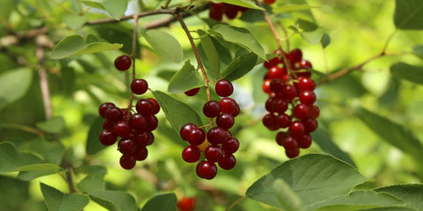Chokecherries
The name doesn’t exactly inspire confidence, right? Who wants to eat something with “choke” in the name? I’m sure they grew in the wild spaces of my childhood, but they weren’t something I thought about eating until I moved to Upstate New York. My dad and I walking down a dirt road near my house, admiring ripening wild grapes and crabapples, when we came upon a shrub with drooping red berries. My “what the heck is that?” was met with incredulity by my father, and a long lecture about chokecherries and their habitats. My follow-up “I assume they aren’t edible” [again, chokecherry] produced another lecture about all the things one can do with chokecherries, and how did I not know this, and obviously he and my mother had done an inadequate job of raising me. I have foraged chokecherries ever since.
Identification
Chokecherry, also known as Virginia Bird Cherry or bitter berry, is native to the continental US and Canada. It matures into a large shrub or small tree, with glossy, dark green, oval leaves 2” to 6” long. The bark ranges from grey to brownish-black depending on the tree’s age. It may be found in thin stands, as dense thickets, or individually in open forest clearings. It prefers direct sunlight, and tolerates a wide range of soil types and textures. In my area, chokecherries are quite common along roadsides and pasture borders.
White racemes of flowers, 3” to 6” long, appear in April, followed by small fruit about ¼” in diameter. Ripe chokecherries, ranging from dark red to almost black, can be harvested mid-July through early September depending on your location. Each fruit has a single seed that is quite large, taking up about one third the volume of the cherry.

Common buckthorn is considered a toxic lookalike. However, the buckthorn has lots of long, sharp thorns, which chokecherries do not have. Common buckthorn berries also don’t contain just a single seed (as chokecherries do) but many small seeds. Tartarian honeysuckle also has bright red fruits, but they grow in pairs on the branch, not in drooping clusters.

Harvesting
Harvest them too early and they leave a bit of a pucker in your mouth. Wait until the cherries are fully ripe and sweeter, and you’ll be competing with your local birds and racoons. Perfect picking time is thus a dilemma for me every year. The leaves, bark, stem, and stone (seed pit) of chokecherry are all toxic to humans and pets and should not be consumed.
I tend to pick the entire raceme, and then pluck off the individual cherries when I get them home.
Uses
The meaty flesh of the fruit is slightly bitter and astringent even when fully ripe. When processed with a little sugar, chokecherry makes excellent wine, jams and jellies, and fruit leather, and is often used to make syrups for sore throats and teas for stomach upset.
Processing
I usually fill my sink with clean water and racemes of chokecherries, pulling each raceme out and stripping the cherries off into a colander. Rinse them well, and you’re ready to go. Letting the washed chokecherries can hang out in the fridge for a few days can sweeten and deepen their flavor. If you’ve got more than you can handle right away, raw chokecherries freeze well. If I know I’m going to use them for jam, I usually measure out four cups and freeze them in a quart-sized freezer bag.
When cooking chokecherries for juice or puree, add enough water to just cover the cherries, then boil them only until the fruit begins to fall from the seed, otherwise the toxins in the seeds can begin to leach into the fruit. I usually mash the cooked mix up with a potato masher before either hanging it in a jelly bag (if I only want the juice) or filtering the seeds out using a colander or food strainer to create a puree (for jam or fruit leather).
Recipes
A simple chokecherry syrup can be made with a 1 to 1 volume ratio of juice to sweetener. (If you use honey or maple syrup instead of sugar, expect a longer boil time to thickening.) Bring the juice and sweetener to a boil in a large pot, then cook at a boil for about 5 minutes or until the mixture thickens slightly. You can preserve this in jars processed in a boiling water bath or steam canner for 10 minutes.
Chokecherry liqueur can be made by adding ½ a cup of sugar to 2 cups of chokecherry juice and heating it until the sugar dissolves, stirring in ½ a cup of Everclear or Vodka, and allowing the mixture to rest in small brown bottles for at least one month.
Chokecherry fruit leather is made by adding ¼ cup of brown sugar (optional) to 4 cups of warm chokecherry puree and pouring the mixture onto a parchment-lined baking tray or a lined dehydrator tray. Cook in an 175F oven for 4 hours or in the dehydrator at 145F for 6 to hours, until the surface isn’t tacky.
Chokecherry jelly and jam both follow the usual formula of four cups of juice or pulp, ¼ cup of lemon juice or 1 tsp of citric acid, 2 cups of sugar, and 1/3 cup of low-sugar pectin. Chokecherries have a fairly high natural pectin content, so some people leave out the powdered pectin and just boil the mix until it thickens. I don’t do it this way because I don’t like how much fluid is lost during the longer boil, but there’s certainly no reason not to try it if it interests you.



